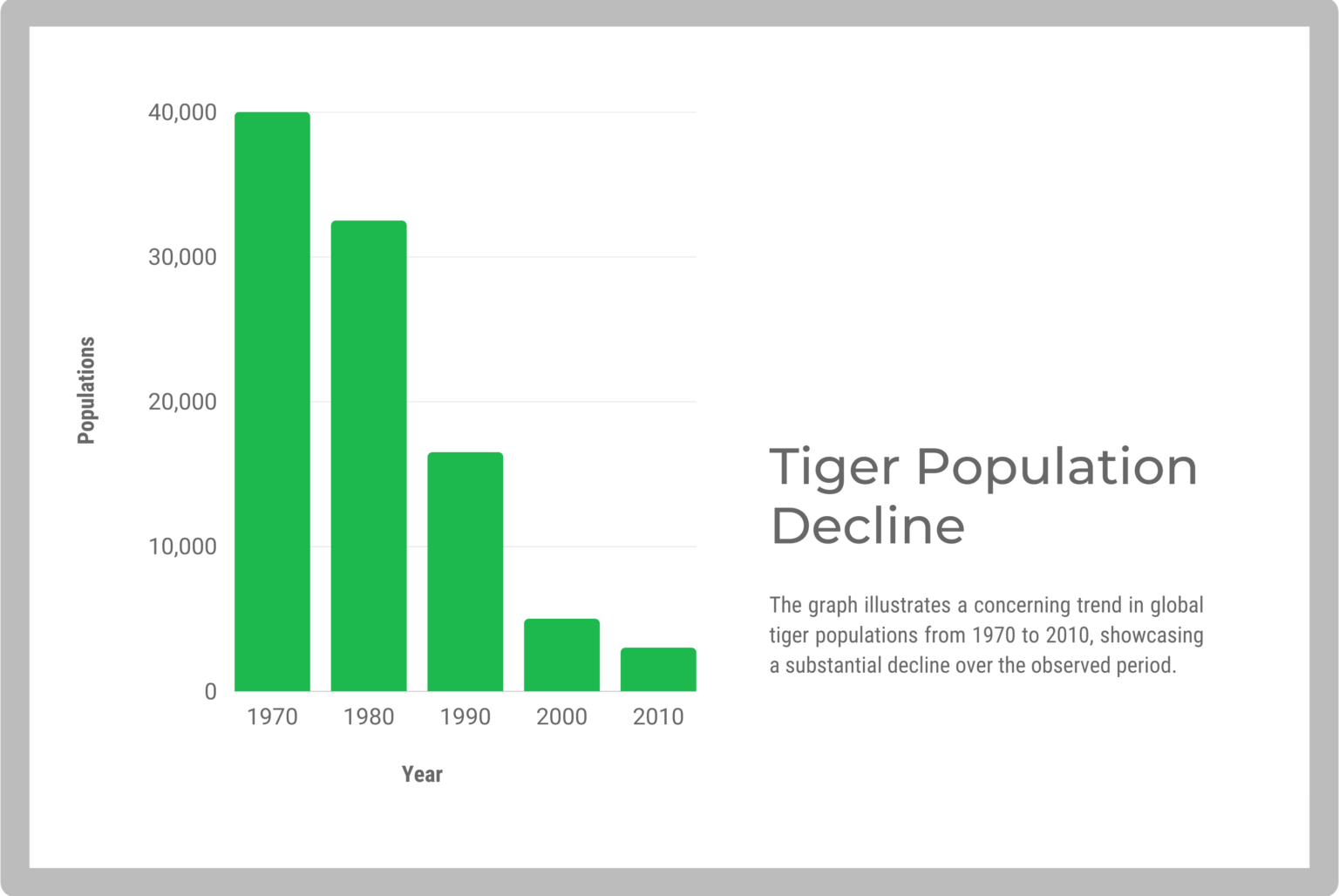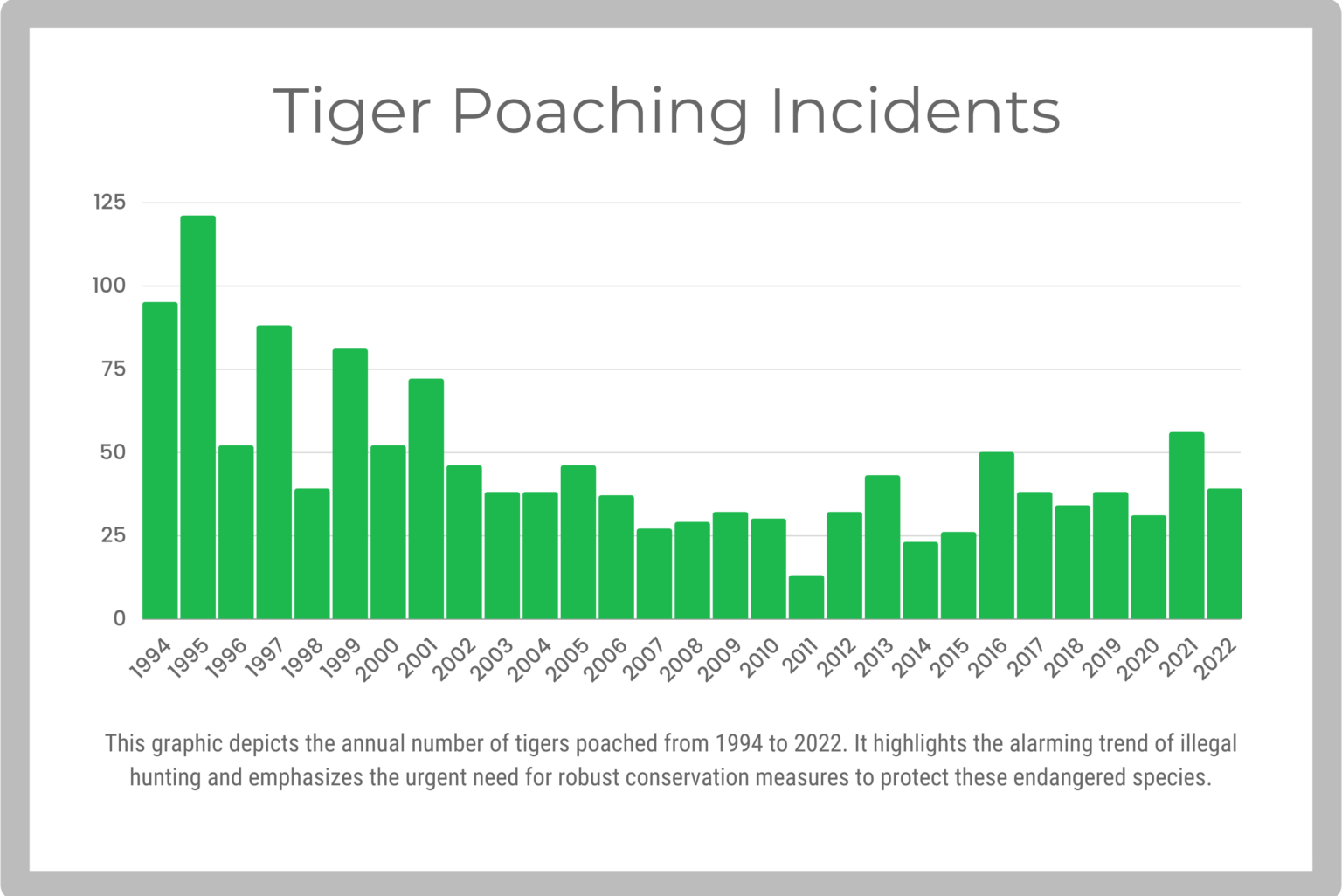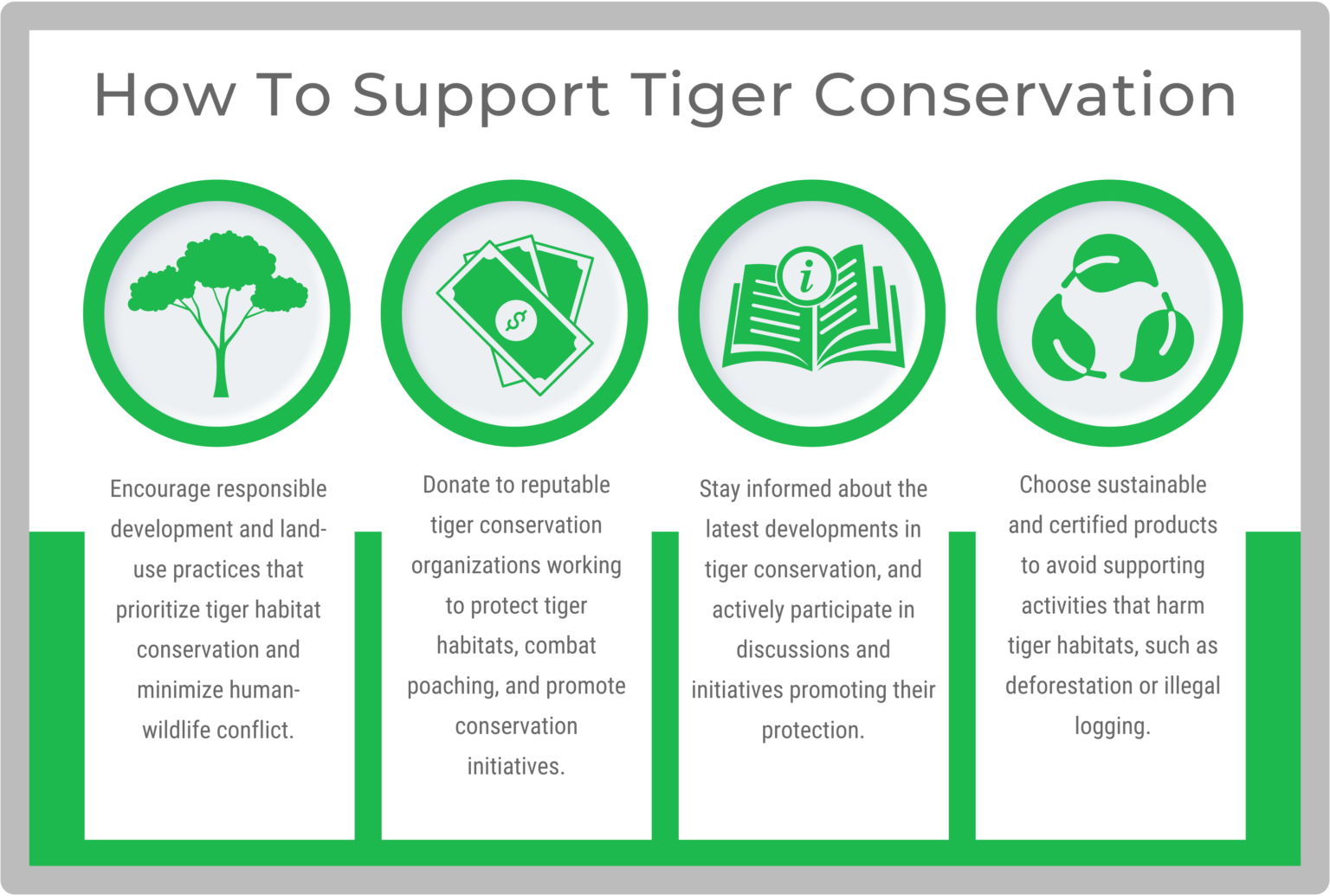International Tiger Day – Facts, Events, and Expert Insights

 Firstly, they are the largest wild cats in the world. They can grow to 3.3m long and weigh as much as 363 kg.
Firstly, they are the largest wild cats in the world. They can grow to 3.3m long and weigh as much as 363 kg.- Tigers only eat meat, as they are carnivorous. Their prey consists mostly of large mammals like buffalo, antelope, wild pigs, and deer. They can eat up to 40 kg of meat in one sitting.
- The United Nations reports a 95% drop in tiger numbers due to habitat destruction and illegal trade over 100 years.
- They are endangered across their range from the Russian Far East to Sumatra, including China, India, and Southeast Asia. About 4,500 tigers remain in the wild.
- These big cats are targeted by illegal wildlife trade, with their parts in high demand. Every year, around 100 of them are killed for this trade
- Fortunately, conservation efforts have led to an increase in populations. India alone has seen a rise from 1,411 to 2,967 the last decade.
- They typically hunt alone and stalk prey. They can reach speeds of up to 65 km/h (40 mph) when chasing prey. They usually kill their prey by biting the throat or neck.
Sources: National Geographic, Save Wild Tigers, WWF, Utopia, David Shepherd Foundation, Traffic
Threats to Tigers
- Poaching: Illegal poaching has killed 2,500 tigers in two decades for the wildlife trade.
- Habitat Loss: Deforestation and human encroachment have reduced their historical range by 93%.
- Prey Depletion: Declining prey forces these wild cats to hunt livestock, impacting their populations.
- Human-Wildlife Conflict: Shrinking habitats lead to conflicts and retaliatory killings.
- Captive Wildlife Crisis: Exploitation and illegal trade from captivity threaten them.
- Climate Change: Alters habitats, affecting prey distribution and tiger vulnerability.
- Infrastructure Development: Roads and dams fragment habitats, isolating populations.
- Illegal Wildlife Trade: Demand for tiger parts in medicine and luxury goods drives poaching.
- Lack of Conservation Funding: Limited resources hinder effective tiger conservation.
- Inadequate Law Enforcement: Weak enforcement enables poaching and illegal trade networks.
Sources: Traffic, WWF, David Shepherd Wildlife Foundation, Utopia, Save Wild Tigers
Expert Insights
“With only ~4,500 tigers left in the wild, there are an estimated 5,000+ privately owned in America. This contrast goes to show the gravity of the Captive Wildlife Crisis. The Captive Wildlife Crisis encapsulates captive wild animals that become victim to buying, trading, selling, abuse, neglect, and beyond. Tigers are no exception. They are heavily trafficked and exploited across the world via roadside zoos, breeding facilities, cub petting operations, and even as pets. Tigers are an endangered species yet more are kept in backyards than found in the wild. Education and awareness are paramount to not only conserving wild tigers, but also to advocating for tigers in captivity.”
The Wildcat Sanctuary (TWS) is the only accredited, non-profit sanctuary in the Midwest. TWS provides a natural sanctuary to wild cats in need and inspires change to end the captive wildlife crisis. Combining natural and spacious habitats with a life free of exhibition, TWS allows all residents to live wild at heart. As a true sanctuary, we do not buy, breed, sell or exhibit animals. The Wildcat Sanctuary is accredited the Global Federation of Animal Sanctuaries. – Tammy Thies, Founder and Executive Director of The Wildcat Sanctuary
“Sumatran tigers are a Critically Endangered species, with no single viable population remaining. They have a suite of problems: habitat loss, prey loss, human conflict and poaching. We must immediately protect their remaining habitat and set up reliable processes to secure both their and their prey’s safety. As well as the transfer of conflict males between populations to maintain the species’ genetic viability as a single mega population of Sumatran tigers. The International Tiger Project, in conjunction with its partners, is working to solve these issues.“ – Leif Cocks, Founder of Wildlife Conservation International
“Significance of International Tiger Day: International Tiger Day is a crucial reminder of the urgent need to protect these magnificent creatures and their habitats. It raises global awareness about the critical state of tiger populations and serves as a rallying point for conservation efforts.
Key challenges faced by tiger populations: Tigers face numerous challenges that threaten their survival. Habitat loss due to deforestation, poaching for the illegal wildlife trade, and human-wildlife conflict are the primary challenges. Tigers are also vulnerable to climate change impacts, which further exacerbate their struggle for survival.
Successful conservation initiatives: Several successful conservation initiatives have shown that tigers can recover when given the chance. Efforts such as strengthening anti-poaching measures, establishing protected areas, promoting community-based conservation, and raising public awareness have had positive impacts on tiger populations in certain regions. Collaborative efforts between governments, conservation organizations, local communities, and individuals are crucial for their success.
One of the biggest threats to tigers is conflict with humans who live in areas neighboring the tiger territory. In this region, climate change has resulted in more erratic monsoons. This has affected the natural rivers and streams. In the dry season, they dry up more quickly than they used to. Thirst causes the tigers to enter the more populated areas they would normally avoid in search of water. This creates a danger to the people and killing of tigers.
Corbett Foundation has a very clever solution: solar powered pumps connected to “bore-wells” to create watering holes for the animals. The wells are made by using a machine to drive pipe 100 to 300 feet into the ground to reach the water level. An array of four 4’ x 8’ solar panels is installed to operate the pump. A chain link fence is erected around the solar array to protect it. The Forest Department constructs the pool that holds the water.
The well, pump, solar panels, and the labor to install these costs $4800 for each well. Our hope this International Tiger Day is to raise $9600 to construct two of these wells to provide water for thirsty tigers so they stay out of harm’s way.” – Carole Baskin, CEO of Big Cat Rescue
“Tigers are an endangered species and are at risk of extinction throughout its range including Nepal. Poaching, human-tiger conflicts, habitat degradation are few of the critical issue of tiger conservation. Nepal Tiger Trust has projects focused on understanding these issues by conducting tiger research, monitoring tigers and assisting park authorities with its resolutions. Our projects include Long Term Tiger Monitoring, Participatory Anti-Poaching, and Tiger Conservation Awareness Campaign. We monitor tigers using pug-mark tracking and camera trapping. Monitoring individual tigers helps us understand their movement patterns, behavior, population structure and identify them during human-tiger conflict situation.
Likewise, we help form a community based anti-poaching or Participatory Anti-poaching Unit in the local communities. These groups work in association with the park authorities, protection units, conduct joint patrolling and keep surveillance by monitoring illegal activities in their localities. Last but not least, we also do tiger conservation awareness in local schools, local communities, and visitors (national and internationals) who visit our field site and eco-tourism lodges in Nepal.
We strongly believe in protection of the tiger in its natural habitat is possible by the front line people and local communities living as neighbors next to tigers’ habitats. However, global community support is equally important to safeguard this beautiful, charismatic, majestic, and powerful animal in its natural habitats.” – Bhim Gurung, Executive Director, Nepal Tiger Trust
Join the Cause
- Donate to reputable organizations working on the ground to protect these creatures habitats, combat poaching, and promote conservation initiatives.
- Raise awareness about the importance of conservation by sharing information through social media, educational campaigns, or public events.
- Support sustainable tourism practices that prioritize responsible tiger viewing and contribute to local communities engaged in conservation efforts.
- Advocate for stronger legislation and enforcement against the illegal wildlife trade.
- Choose sustainable and certified products to avoid supporting activities that harm wildlife habitats, such as deforestation or illegal logging.
- Avoid pay-to-pet schemes using cubs, purchasing products made from their parts, or contributing to the illegal wildlife trade.
- Support initiatives that promote community-based conservation and involve local communities in conservation efforts.
- Encourage responsible development and land-use practices that prioritize conservation and minimize human-wildlife conflict.
- Stay informed about the latest developments and issues in conservation, and actively participate in discussions and initiatives promoting their protection.
Source: Big Cat Rescue
Organisations to Support
- Panthera Dedicated to conserving the world’s 40 wild cat species, including tigers. Notably, Panthera’s flagship program, Tigers Forever, aims to increase their numbers by 50% over 10 years at key sites across Asia.
- Born Free Dedicated to the welfare and conservation of wild animals, including tigers. Additionally, their Living with Tigers program supports Indian conservationists who protect habitats, prevent conflict, tackle wildlife crime, monitor populations, and enhance local livelihoods. Furthermore, Born Free campaigns against exploitation and abuse in captivity.
- The Wildcat Sanctuary A non-profit rescue providing a natural sanctuary for wild cats in need. It does not breed, buy, sell, or exhibit its residents. Moreover, the sanctuary educates the public about the wildlife crisis and conservation importance.
- WWF Working since 2010 to save these creatures from extinction by securing habitats, disrupting illegal trade, changing consumer behavior, connecting landscapes, and empowering communities. Additionally, WWF partners with governments, organizations, and locals to double the wild population by 2022.
- Big Cat Rescue A non-profit animal sanctuary founded by Carole Baskin, providing a permanent home for abused, abandoned, and neglected big cats. Furthermore, the organization advocates for ending private ownership and exploitation.
- ITP Aims to protect and save habitats in Borneo and Sumatra. It works with local communities, provides technical and financial assistance, and monitors with camera traps. Additionally, it supports conservation of other endangered species and the rainforest ecosystem.
- Nepal Tiger Trust A non-governmental organization monitoring and protecting tigers in Chitwan National Park. Established in 2010, it collaborates with stakeholders using camera traps, pugmark tracking, patrols, and educational programs.
- Saving India’s Tigers A coalition of NGOs conserving tigers and habitats in central India’s Satpuda landscape. Founded in 2005 with Born Free Foundation support, it addresses threats through collaboration with local communities and government bodies.
- PrideRock Wildlife Refuge Located in Kaufman County, Texas, it rescues and cares for mistreated wild animals. Founded by Gary and Carol Holliman, it promotes conservation through education.
- Tigers4Ever A UK-based charity dedicated to conserving wild tigers in Bandhavgarh National Park, India. Founded in 2010, it focuses on anti-poaching patrols, community education, and creating waterholes to reduce conflict.
- Tiger World Located in Rockwell, NC, it is a nonprofit dedicated to rescuing, rehabilitating, and preserving exotic animals. It offers guided and self-guided tours for up-close experiences.
- For Tigers Aims to improve the welfare of captive tigers in Thailand through assessments, education, and direct aid to facilities. Their mission includes promoting humane interactions and improving conditions.
- FOUR PAWS Focused on rescuing and protecting animals under human influence worldwide. They combat cruelty, provide species-appropriate homes, and advocate for better treatment.
- Saving Wild Tigers A volunteer-driven charity focused on protecting wild tigers and their habitats, particularly in India. They work on habitat preservation and community support, enhancing wildlife research and awareness.
- WildCats Conservation Alliance A partnership between Dreamworld Wildlife Foundation and Zoological Society of London focused on saving wild tigers and Amur leopards. They support projects addressing anti-poaching, monitoring, and habitat preservation.
- The National Tiger Sanctuary A non-profit rescue organization providing a permanent home for exotic and domestic animals. It focuses on environmental preservation, exemplary care, and unique educational programs.
- Crown Ridge Tiger Sanctuary Rescues and provides lifelong care for abused, neglected, or unwanted big cats. It educates the public about the captive wildlife crisis through presentations, tours, and educational programs.
- The Wildheart Animal Sanctuary Located in Sandown on the Isle of Wight, it rescues and protects endangered wildlife. Managed by The Wildheart Trust, it supports in-situ conservation projects and offers educational experiences.
- The Exotic Feline Rescue Center (EFRC) Located in Center Point, Indiana, it is a sanctuary for abused, neglected, and unwanted exotic felines. Founded in the 1990s, it cares for over 100 cats and foxes.
- In-Sync Exotics Established in 2000 and based in Wylie, Texas, it rescues neglected, abused, and unwanted exotic felines. The sanctuary provides lifelong care and educates the public on responsible ownership and conservation issues.
- Wildcat Ridge Sanctuary Dedicated to rescuing and rehabilitating exotic cats, it provides a safe haven for abused or neglected animals. The sanctuary focuses on education and conservation, raising awareness about protection.
- Save Wild Tigers Dedicated to safeguarding endangered big cats through awareness, fundraising, and collaboration globally. They focus on habitat preservation, anti-poaching efforts, and community engagement to ensure these majestic animals’ survival.
- Colchester Zoo’s Action for the Wild is a charity that supports conservation projects worldwide, including those that protect them and their habitats. For example, it has donated to the Wildlife Vets International, which provides veterinary care and training for conservation in India, Nepal and Russia. It also supports the 21st Century Tiger, which funds conservation initiatives across Asia. By donating to these projects, Colchester Zoo’s charity helps to ensure the survival of these endangered animals.
Adopt a Tiger
Events 2024
- The “Run For Tigers” organized by WWF-Malaysia and Maybank, this event is on July 21 at Kepong Metropolitan Park, Kuala Lumpur. This 3.5 km fun run aims to raise awareness and funds for the critically endangered Malayan tiger. Additionally, join the costume contest with a cash prize; RM10 per registration supports WWF-Malaysia’s conservation efforts.
- Crown Ridge Tiger Sanctuary celebrates International Tiger Day with themed activities, including face painting, story times, and carnival games. Moreover, visitors can meet the keepers, join tours, and enjoy food from local vendors. The event also includes a silent auction with unique items, such as a Keeper for a Day experience. Gates are open from 10 am to 2 pm, with admission at $10 per person (free for kids 3 and under).
- The National Tiger Sanctuary is hosting a Raffle a raffle for 2024, participants can purchase tickets for a chance to win various prizes. Raffle funds will support the sanctuary’s mission to care for and protect their animals. Furthermore, the raffle offers an engaging way for supporters to contribute while potentially winning exciting rewards.

